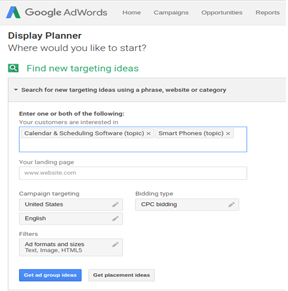SEO
Free SEO Analysis
SEO Services
Content Marketing Services
Local SEO
Link Building Services
Specialized SEO Services
PPC
REPUTATION MANAGEMENT
Free Reputation Management Analysis
Reputation Management Services
Review Management Services
Specialized Reputation Management Services
CEO Reputation Management
Brand Enhancement
Business and Directory Listings
Comprehensive Reputation Management Audit
SOCIAL MEDIA
Free Social Media Analysis
Specialized Social Services
WEB DEVELOPMENT
Free Website Analysis
Web Design Services
Mobile Development Services
Website Maintenance Services
Specialized Development Services
MARKETING AUTOMATION
Free Marketing Automation Analysis
Specialized Marketing Automation Services
Comprehensive Marketing Automation
INDUSTRIES
ABOUT DMA
SEO
How to do SEO For a Small Website With Big Goals
Request a quote
Its Fast, Easy & Free
Executive Summary
- Almost 90% of all online experiences starts with a search engine, and more than 70% of internet users neglect the paid links at the top of the page, looking instead for organic search results.
- The best way to start with SEO is to start planning your content. This method is known as a Content Strategy.
- In order to leverage your online presence, you have to always keep up with the latest SEO trends and do your best to have a completely optimised website at all times.

A search engine optimization (SEO) strategy involves hundreds of actions that have to be planned and executed perfectly. When you look at the scope of the tasks to be done, it becomes quite apparent why people with small websites give up on the idea of investing in SEO.
You can start optimizing your website gradually, without harming your budget, no matter how small it is. SEO done right will increase your online visibility, help you to establish a better online presence, generate more traffic on your website, and help you to start moving toward bigger goals.
Here is what you have to know and do to transform your small website into a conversion, engagement, traffic, and revenue haven.
Why SEO Works Best for Small Websites

Let’s get one thing straight — SEO is the most effective marketing method! A lot of core SEO practices that were used in the past are still viable today, and that’s not likely to change.
Almost 90% of all online experiences starts with a search engine, and more than 70% of internet users neglect the paid links at the top of the page, looking instead for organic search results. In fact, the first ad position on a Google search results page has a . On top of that, spending on SEO marketing is expected to rise to almost $50 billion by 2019.
As we already mentioned, an SEO strategy can be developed so that it doesn’t hurt your budget. SEO marketing is more cost-effective when compared to other forms of online marketing (lead purchasing, social media marketing, PPC advertising, and more). When you look at it from the point of an investor, even if you decide to use Google AdWords, you should estimate your earnings to be $3 for every $1.60 spent.
SEO will allow you to provide users with what they need and start to position yourself as an expert in the industry. SEO is not about finding good keywords and optimizing your website for mobile devices. If you apply the best organic SEO practices to your content, people will easily find you. Why? Because people are not mindlessly shopping online. Before they reach their final decision, they want more information, and your content can be there when they need it.
One necessary SEO methods is mobile optimization for your website. There are currently almost 2.5 billion people online, and half of them use their smart devices to access the internet. If you do this part of SEO, your small website will be ranked higher and have a higher chance of being found by mobile web surfers.
Finally, you should focus on SEO for your small website because other small websites, as well as your competitors, are doing it. If you don’t, you’ll jeopardize your website’s position, and the competition will take your place on the search results page.
Remember, SEO is an ongoing process, and you can start working on any of the methods below to begin implementing an overall SEO strategy to help grow your website and generate money.
Content Planning

The best way to start with SEO is to start planning your content. This method is known as a Content Strategy. The content is what will make people come to your website, and people are the one thing that can help you achieve big goals even with a small website.
If you think that you don’t have the time or resources to plan your content strategy, we urge you to reconsider your decision. Creating and posting valuable and authoritative content on your website will help you get big. This is why we recommend that you start with blogging. It is easy and will help you launch your content very fast and see positive results quite soon.
Keyword Research
Since you are a small player, it is recommended that you make a switch from a traditional keyword search to people problems, pain points and what your target audience needs. Let’s say that you are a small mobile development company and you have a small website.
You want to use it to promote your app and get more downloads on the App Store or Play Store. In order to find the inspiration for your new blog content, you have to get into the mobile app user’s shoes. How do you do that?
The best way to do this task successfully is to take a dive into your app users’ comments and the ones on your competitors’ apps. This will help you identify the good sides, real-life use cases and problems the users of this particular app category face. This will provide you with a number of ideas for your content.
Now that you know what the audience needs, you can go to keyword research, but with a focus on long-tail keywords? Why? Because they offer good results in a short period of time and they are much easier to focus on when you are new to SEO. Some companies even report that long-tail keywords generate 2.5 more traffic than head terms.
Let’s use the same example from above and assume that the mobile app development company has an app called “Incredible Scheduler”. Instead of focusing on the Incredible Scheduler head keyword, you can sit down and write several long-tail ones – e.g. “mobile apps can help you achieve work-life balance”, “never miss an appointment with these mobile apps”.
Type in these long tail keywords in Google search and see how many results there are. The number will tell you how many blogs and articles are there and with whom you are competing.

As you can see, there are 19 million results. While these odds don’t look good, you get the idea. In addition, you can log in to Google Adwords and do some research on the same long tail keyword.

Aha, now this looks interesting. The result shows that there are 10-100k average monthly searches for this long tail keyword. This means that there is interested audience for this topic.
Let’s see an example of long-tail keyword research and implementation in title creation.
Title Creation
This is where things get more interesting. You’ve done your long tail keyword research and went through the comment section of your app, as well as those of the other apps in your category. This information can help you to get dozens of interesting topics to write and post articles on in the future. Now you need to give your best to include your long-tail keywords in the titles.
The hardest thing is to come up with a title that's no longer than 60 characters, contains your keyword and still appears natural. You are allowed to be creative – in fact, the more interesting your article headline is, the more engaging it will be for the audience.
There is only one rule you absolutely have to abide by though, make sure that title always corresponds to the main theme of your article.
Content Optimization
Here’s your new motto: “Write and create for people, but optimize for Google!” Make sure to understand that people come first and SEO is a close second. The general advice for small websites is to start with a blog. Make sure you regularly post articles that appeal to your audience and solve a specific problem for them.
There are two words in SEO terminology to pay attention to – relevance and authority. Google assesses relevance by analyzing how many times you used specific keywords in your content and where you placed them.
And authority applies to the number of links on other websites pointing to the content on your blog. Nail both of these and you will have a high quality piece of content that is highly valued by Google, especially after the Penguin and Panda updates.
Creative copywriting is a form of art and it can take some time for you to master it. Here is a cheat sheet that can help you get started quickly and easily.
Publishing & Promotion
Important parts of your content strategy are publishing and promotion. Both of these depend on the audience you are trying to appeal to. Publishing refers to how often you should post new content on your blog while promotion involves spreading the word across social media platforms and posting or getting mentioned on high ranked websites in your niche.
One of the Moz studies from 2015 states that articles of 1,000 words consistently receive more shares and links than the shorter ones. The scale of this study was huge and it incorporated more than 1 million articles online. So, make sure that your posts are long, relevant and valuable. One question remains though: “How often should you post?”
According to SEO experts two to three posts per week is a great start. This will allow you to pile up a lot of posts on your website in a matter of months, which has significant SEO benefits.
When it comes to promotion, in your early days you should consider some of the legacy methods which are still completely viable. Once you have a dozen posts published on your blog, you can start building your email list. This is one of the best methods of turning organic traffic into engaged readers who come back to read what you’ve published.
Also, make sure to include a link to your website/blog in all of your social media profiles and to share your posts on social media as soon as you publish them. You should also start commenting on other people's blogs in order to attract more attention and drive traffic to your website. Refrain from the latter method if you don’t have valuable and relevant posts to the post you are about to leave a comment on.
Reaching out to others is another viable promotional method. Ask established bloggers and influencers in your industry to share your content. Don't be afraid to ask. One “yes” can result in a huge website traffic spike.
And last, but not least start participating in conversations and answering people's questions on Reddit and Quora. Don't forget to include links to your blog posts in your answers. Just make sure to provide valuable answers.
You can even provide some in-depth advice if there is a lot to say on the topic. Look at the time and effort devoted as a long-term investment, as these platforms will generate website traffic for months, maybe even years to come.
On-Page Optimization

On-page optimization, or on-page SEO, includes methods that can be directly applied to the website so that search engines rank it better. Besides, on-page optimization will improve the performance of your website and raise user experience to another level, thus improving its visibility and attracting more visitors to it.
URL Format
The first thing we will address are URL strings. Shorter URLs are ranked better. Short and descriptive URLs will help people to guess with 100% accuracy what is behind the link. In our example: “https://incrediblescheduler.com/blog/real-life-use-cases” would be a good example.
Formatting your URLs in this fashion is beneficial because the anchor contains your target keywords and your links will be highlighted by Google when they match the search inquiry, making them clearly visible to users.
Include Alt and Meta Tags
Meta tags are used by search engines to get more information about your website and SEO experts still refer to meta tags as crucial elements of on-page SEO. Google’s ranking algorithm has changed over the years, however, making some meta tags less effective than before. Still, if you use them you will improve your ranking factor.
The first meta tag you will need is your title tag. These are the words that appear on the browser’s tab label when users are on your website. They are also seen on search engine results, both for paid ads and organic results.
The title tag has to nicely sum up what the page is about. If it corresponds to the content of the page Google will rank your page higher. Here is a follow up on our previous example (character limit for page titles is 70):
<title>5 Real Life Use Cases of Incredible Scheduler</title>
The next meta tag is the meta description. It has to be short and help the internet surfers get a quick glimpse at what awaits them on the page before they click on the link on the search results page. Good meta description equals high click-through rates. Since your website is small, it won't be a problem to fill in the meta description for each of the pages. Keep it between 165 and 175 characters.
Remember when we talked about writing blog posts for your website? Well, make sure to use heading tags as they are another important aspect of meta tag optimization. Each of your articles should have only one <h1> tag while the subheadings should be organized in <h2> and <h3> tags.
Since images are a big part of the user experience, you will probably post them as a cover for your blog post and inside the article to get users engaged with specific subheadings and break up walls of text. This is why you have to use proper alt tags for images.
In addition, Google places high value on alt texts. While all images should have a short alt text, you should use one of them to place your focus keyword. Don't unnecessarily flood alt tags with keywords. It won't get you a higher rank, and it will certainly damage the user experience.
Site Speed Optimization
Google is not quite clear on whether they rank fast websites higher or not, but it will certainly affect other important SEO metrics such as average time spent on page. Why? Because users won’t wait for slow sites to load, especially the mobile users. Fast loading websites have excellent usability and great engagement.
Since you own a small website, optimizing its speed won't take much time and it will set a healthy and stable foundation to build upon. First you will have to reduce HTTP requests so that your pages get rendered faster.
If you are not familiar with web development, you should consider hiring a professional developer. Primary task: simplify your website design! What does this mean? It means less elements per page, minimize the use of scripts, use CSS instead of images, consolidate the entire CSS code in one file, etc.
Another thing that you should do is optimize the images on your website. They should be JPG, resized to fit the screen of your visitor, and each has to be properly linked with an SRC attribute in your HTML <img> tag.
Mobile Optimization
You absolutely have to optimize your website for mobile platforms. There are 2.5 billion people online and half of them are accessing the internet via mobile devices on a regular basis. If you don't optimize for mobile platforms, you will be outranked by competitors who have worse SEO than you. So, your first stop should be a test designed by Google to identify what you need to make responsive or more responsive.
One of the main things that you have to address when working out a responsive layout for your website is to make things big enough to allow your mobile visitors to access the functionality of your website with no issues.
Building a Social following
With social media platforms, marketing has become an interactive medium. The social media platforms provide you with vast opportunities to turn your small website into a major digital cross section with a McDonald's-style drive through. This is why you have to start growing your social media followers as soon as possible.
But creating a following that trusts you is not an easy thing to do. In order to do this, you have to start building a following with whom you can relate to, and that is the audience that you care about the most. You will be able to create the best content only if you write it for someone that you understand and truly care about.
Produce the content as if the money or traffic weren’t the intended outcome, and focus on engaging your readers. Share your posts regularly and participate in the conversations. If you want to speed things up, use any of the paid ad tools on social media platforms to reach your target audience faster.
If you are not sure how to find out more things about your audience and you are on a budget, head to the Google Ads Display Planner. Select “Search for new targeting ideas using a phrase, website or category” and enter what your customers are interested in. Following the example from this article, here is how it would look.

These SEO methods will help you increase the traffic on your small website and use this potential to reach bigger goals. In the end, I will have to repeat myself, SEO is an ongoing effort. In order to leverage your online presence, you have to always keep up with the latest SEO trends and do your best to have a completely optimised website at all times. Fortunately, your website is small, so you can learn and improve it as you go.
Our Sales team